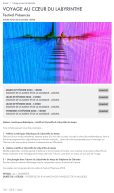SdG CREATION
Copyright SdG 2023 - All rights reserved
Legal Notice

PEDAGOGY
A word of introduction
The Labyrinthe du Temps educational space has been developing steadily for over 20 years.
These digital learning and play tools are unique (registered trademark), the result of research, programming, experimentation in the educational field, and creations by the Labyrinthe itself.
These digital installations can be installed in any learning environment for children aged 7 and over (conservatories, schools, universities, museums) or open to the general public.
One example is the world premiere installation of the Labyrinthe du temps digital workshops at Radio-France during the "Présences 2023" international festival of contemporary creation.
For more specific learning (master-classes, conferences, courses), a unique database (with courses and practical work) is also available on the Internet.
Contact for commissions, digital educational installations, workshops, master-classes
Contact: sdegerando@gmail.com
Example of a very simple technical installation (one computer, 4 speakers, one large screen) for various educational and creative activities on offer
1 - Didactic digital workshops for the Labyrinth of Time
Discovering sound and its parameters, drawing curves with the voice, listening to the song of mathematics, making the link between algorithmic programming and musical invention... these are just a few of the notions on offer to explore the history and challenges of contemporary creation in the 21st century.
2 - Labyrinthe du temps creative and interactive workshops
Augmented reality, remote gesture control and facial recognition, sung improvisations, poetic writings, corporal, gestural, textual and musical scores, creation of controlled tableaux via tablets or telephones... you can invent your own Labyrinthe du temps by controlling and interacting in real time with the work, both in terms of sound and image.
3 - An immersion in Stéphane de Gérando's Labyrinthe du temps
Active listening and discussion with the composer around excerpts from the work.
A program of discovery and experimentation can be decided according to the number of sessions and the level of students or adults.
Click on the document below (12 pages) for detailed information

DIDACTICIELS (exemples)
- title : Algorithmic memory creation
Levels 1 and 2, duration: 16 min
Software used : MAX MSP
Summary: Stéphane de Gérando presents two examples of "memory" creation in the MAX programming environment (coll and histo). These simple examples show how data can be stored or analyzed for reuse in deterministic (combinatorial) and probabilistic (random) algorithmic compositional writing.
- Title: Study of Platonic objects
Level 2, duration: 8 min
Software used: MAX MSP JITTER
Summary: Stéphane de Gérando proposes a "eucliden" mapping between real-time control of Platonic solids and automated control of a synthesizer.
- Title: Introduction to Audacity - Part 1, recording
Level 1 (initiation), duration: 7 min 30 s
Software used: Audacity® is free software (MAC and PC) for recording and editing sounds.
Summary: Stéphane de Gérando shows how to make a recording in Audacity using the internal resources of a computer (MAC), emphasizing the checks to be made before running any software involving audio.
- Title: Introduction to Audacity - Part 2: Editing, processing, analysis
Tutorial level 1 (introduction) duration: 16 min 46 s
Software: Audacity® is free software (MAC and PC) for recording and editing sounds.
Summary: Based on the recording of a short sequence at the start of the video, Stéphane de Gérando shows how to use Audacity's main functions (introductory basics with notions of electroacoustic editing).
- Title: Invention of sound material through filtering
Level 1 (introduction), duration: 5 min 47 s
Software: AudioSculpt is a software package for visualizing, analyzing and transforming sounds (IRCAM).
Summary: Using an example from his piece Le porte dell'inferno, Stéphane de Gérando shows how to create sound material using a simple and common electroacoustic technique: bandpass filtering with AudioSculpt software.
- Title: Space composition, SPAT software (FLUX)
Level 2, duration: 14 min 33 s
Software: SPAT (IRCAM Tools from FLUX)
- Summary: As a first introduction to the SPAT spatialization software, Stéphane de Gérando shows, using one of his works in progress, how to configure Protools and work on sound spatialization (example in 5.1).
- Title: Binaural encoding tool, "Hear" plug-in (FLUX)
Level 1 Video length: 6 min 59 s
Summary: Stéphane de Gérando demonstrates the characteristics of a binaural mix, then, using the example of one of his works in progress (originally in 5.1), Le porte dell'inferno, the composer proposes a comparative application between FLUX's "Hear" plug-in and a "classic" stereo mix.